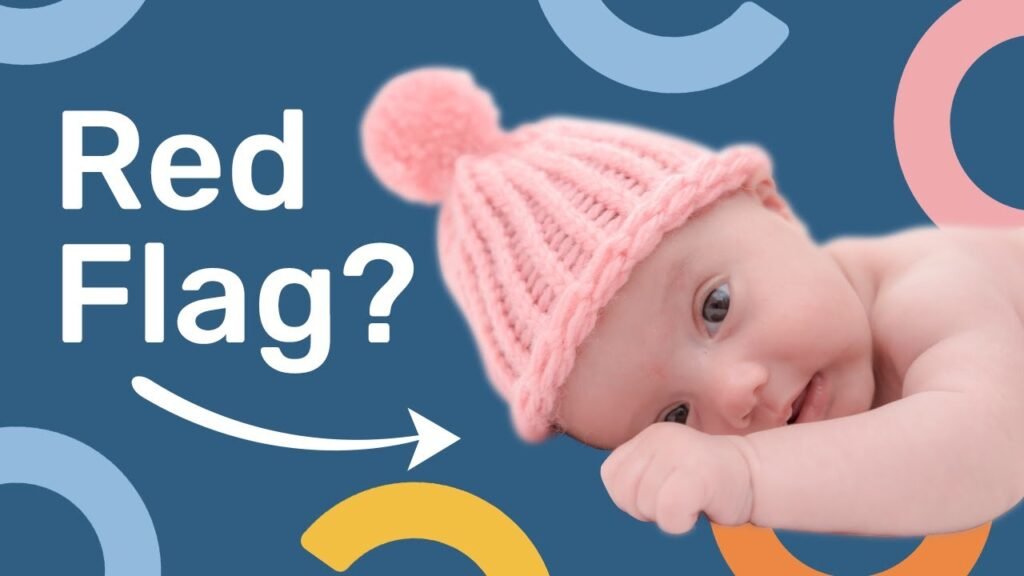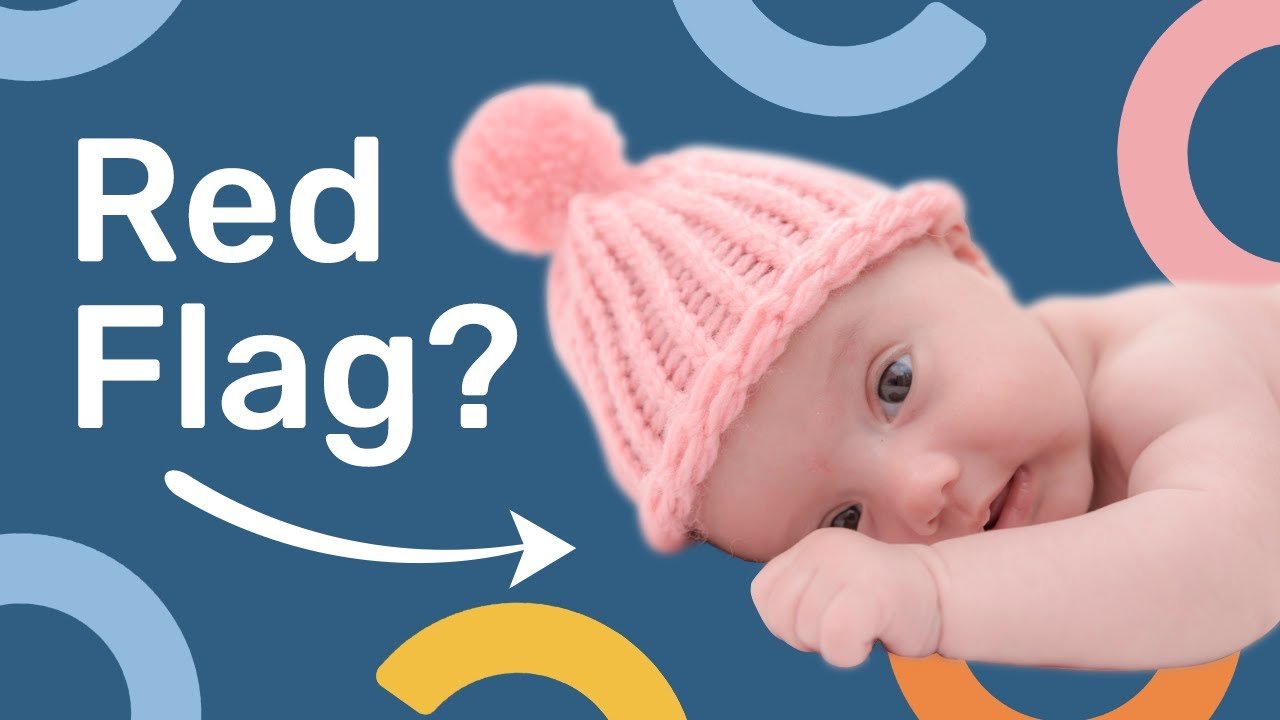Parents play a crucial role in identifying and addressing developmental red flags in their babies. These red flags are indicators that health professionals look out for to identify potential developmental issues. Early identification of these red flags allows for early intervention, which can greatly reduce the impact on a child’s development. As a parent, you are in the best position to notice these red flags and seek professional advice if needed. Some red flags to look out for at three months old include limited head control, constant head turning to one side, and the development of a flat spot on the back of the head. Other red flags include decreased movement or stiffness on one side of the body, a fisted hand with the thumb inside the palm, and a lack of crying or response to loud noises. It is important to seek professional assessment and treatment if any of these red flags are observed. Additionally, it is important for parents to be aware of newborn cues and how to effectively communicate with their baby.
Importance of Parents’ Role
Parents play a crucial role in identifying potential developmental red flags in their babies. As a parent, you spend the most time with your little one and are in the best position to notice any changes or behaviors that may indicate a developmental issue. Early identification of these red flags is important because it allows for early intervention, which can significantly reduce the impact on your child’s development. By being attentive and observing your baby closely, you can play a key role in ensuring their healthy development.

Early Identification of Developmental Red Flags
Developmental red flags are indicators that health professionals look for to identify potential developmental issues in babies. These red flags may range from physical signs to behavioral cues. It is important for parents to be aware of these red flags and to seek professional advice if they notice any of them in their baby. Early identification of these red flags allows for early intervention, which can address the issue and support the baby’s development.
Effect on Child’s Development
Early identification and intervention for developmental issues have a significant impact on a child’s development. By addressing these red flags early, parents and professionals can work together to provide the necessary support and interventions to promote optimal development. Untreated developmental issues can have a long-lasting impact on a child’s physical, cognitive, and social-emotional well-being. By addressing these issues early, parents can help their child reach their full potential and ensure their overall well-being.
Parents as Key Observers
Parents are the primary observers of their child’s development. They have a unique perspective and intimate knowledge of their baby’s behaviors, growth, and milestones. As a parent, you spend the most time with your little one and are attuned to their unique characteristics and patterns. By being vigilant and attentive, you can notice any changes or red flags that may indicate a potential developmental issue. Your observations and insights are invaluable in identifying any concerns and seeking professional help if needed.
Developmental Red Flags at Three Months Old
At three months old, there are specific developmental red flags that parents should be aware of. These red flags may indicate the need for further assessment or intervention. By being familiar with these red flags, parents can take proactive steps to ensure their child’s development is on track.
Limited Head Control
One of the red flags to watch out for at three months old is limited head control. By this age, babies should be able to lift their heads to a certain degree when they are in tummy time or when they are being held with support around their ribcage. If your baby is struggling to lift their head or cannot support it when being held, it may be a sign of developmental delay. It is important to consult with a healthcare professional who can assess your baby’s head control and provide guidance if necessary.
Constant Head Turning to One Side
Another red flag to be aware of is constant head turning to one side. At three months old, babies should be able to turn their heads easily from one side to the other. If your baby consistently prefers to look in one direction and has difficulty turning their head to the other side, it may indicate positional torticollis, which is a tightening of the neck muscle. Positional torticollis can affect the baby’s posture and lead to a flat spot developing on the back of their head. Seeking professional advice can help address this issue and prevent further complications.
Flat Spot on the Back of the Head
A flat spot developing on the back of the baby’s head is another red flag to be aware of. While it is common for newborns to have an unusual head shape initially, it typically resolves by six to eight weeks. If you notice a persistent flat spot developing on the back of your baby’s head after this point, it is important to consult with a pediatric physiotherapist. They can provide advice on positioning and assess if there is an underlying reason for the flat spot. It is also crucial to rule out craniosynostosis, which is the early closure of sutures in the skull and can affect skull growth and brain development.
Other Developmental Red Flags
Apart from the red flags specific to three months old, there are other developmental red flags that parents should be aware of. These red flags may indicate potential developmental issues and require further assessment.
Decreased Movement or Stiffness on One Side of the Body
If you notice that your baby has decreased movement or stiffness on one side of their body, it may be a red flag for a developmental issue. Babies should be able to use both hands freely, reaching out with them and kicking with both feet. They should also be able to turn their head in both directions. If your baby exhibits increased stiffness in one arm or leg or has a strong hand preference, it is important to consult with a pediatrician. They can evaluate if there is an underlying reason for the decreased movement or stiffness.
Fisted Hand with Thumb Inside the Palm
At three months old, babies should have open hands with their thumbs out. If you notice that your baby’s hand is fisted and their thumb is resting inside their palm, it may hinder their ability to grab and play with toys, which they typically start doing around four months of age. If your baby’s hand does not open, consult with a pediatric occupational therapist who can provide guidance and interventions to help with hand development.
Lack of Crying or Response to Loud Noises
Crying is an important form of communication for babies. If your baby does not cry when they are uncomfortable or hungry, it may be a red flag. Crying is their way of expressing their needs and wants when they cannot yet use words. Additionally, babies should respond to loud noises by quieting down, looking for the source of the noise, or start to cry. If your baby does not respond to loud noises, it is important to have their hearing evaluated by a healthcare professional.
Seeking Professional Assessment
It is important to seek professional assessment and advice if you notice any developmental red flags in your baby. Professional evaluation can help confirm whether there is a developmental issue and guide appropriate interventions. As a parent, it is normal to have concerns and questions about your child’s development. Seeking professional advice can provide the reassurance and support you need to ensure your child’s well-being.
Importance of Professional Evaluation
Professional evaluation by healthcare professionals, such as pediatricians, pediatric physiotherapists, and pediatric occupational therapists, is crucial in assessing and addressing any developmental concerns. These professionals have the knowledge and expertise to identify potential issues and provide appropriate guidance and interventions. Early identification and intervention can significantly improve outcomes for children with developmental issues.
When to Seek Professional Advice
If you notice any of the developmental red flags discussed earlier, it is important to seek professional advice. Trust your instincts as a parent and consult with a healthcare professional if you have any concerns about your child’s development. They can assess your baby’s development, address any concerns, and provide appropriate recommendations and interventions, if necessary. Remember, seeking professional advice does not necessarily mean there is a problem, but rather ensures that your baby receives the support they need for optimal development.
Communication and Newborn Cues
Understanding newborn cues and effective communication with your baby are essential for their overall development and well-being. By recognizing and responding to your baby’s cues, you can foster a strong parent-child bond and support their social-emotional development.
Understanding Newborn Cues
Newborns communicate their needs and feelings through cues such as crying, facial expressions, body movements, and sounds. It is important for parents to learn and understand these cues to meet their baby’s needs effectively. Cues may vary from hunger and tiredness to discomfort or the need for stimulation. By being attentive and responsive to your baby’s cues, you can provide them with the appropriate care and support they need.
Importance of Communication with Baby
Effective communication with your baby is crucial for their development and overall well-being. Communication goes beyond just spoken words. It includes using facial expressions, eye contact, touch, and gentle vocalizations to connect with your baby. By engaging in responsive and positive interactions, you can build a strong foundation for their language and social skills. Talking, singing, and reading to your baby from an early age also promote language development and cognitive skills.
Remember, you are your baby’s best advocate and observer. By being aware of developmental red flags, seeking professional advice when needed, and fostering effective communication, you can provide your child with the best possible support and ensure their healthy development.

